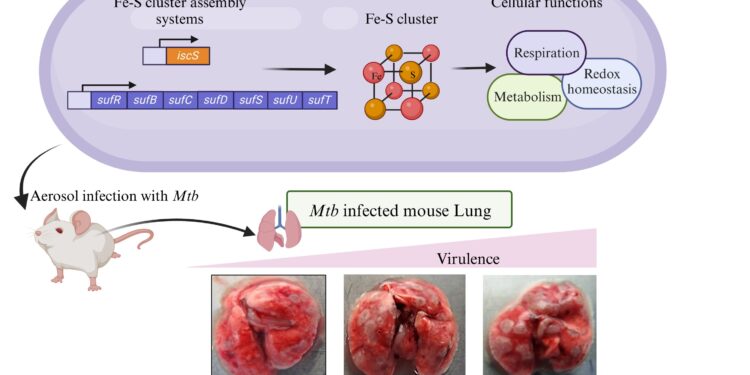IscS- and SUF-mediated Fe-S cluster biogenesis controls Mtb persistence. Credit: Mayashree Das (created with Biorender)
Researchers from the Indian Institute of Science (IISc), in collaboration with NCBS and InStem, have discovered an important mechanism that allows the tuberculosis (TB) bacteria to persist in the human host for decades. They discovered that a single gene involved in the production of iron and sulfur clusters could be crucial for the persistence of the tuberculosis bacteria. The study was published in Scientists progress.
Tuberculosis (TB) is caused by the bacteria Mycobacterium tuberculosis (Mtb), which can be present in the human body for decades without any symptoms. “ATV needs humans to survive. In many cases of ATV infection, the immune system can detect the virus and eliminate it,” says Mayashree Das, first author and doctoral student. student at the Department of Microbiology and Cellular Biology (MCB), IISc.
However, in many asymptomatic individuals, Mtb hides in deep oxygen-limiting lung pockets and enters a dormant state in which it does not divide and is metabolically inactive. In doing so, it successfully hides from the immune system and anti-tuberculosis drugs.
“Because of persistence, there is a bacterial reservoir in a subset of the human population that can reactivate and cause infection at any time. If we do not understand persistence, we will not be able to eradicate tuberculosis.” says Amit Singh, associate professor at MCB. and corresponding author of the study.
Singh’s team grew Mtb in liquid cultures containing special supplements required for its growth in a state-of-the-art Level 3 Bio Safely facility at the Center for Infectious Diseases Research (CIDR), IISc. Several MTB proteins depend on iron-sulfur clusters to function. These clusters are made up of iron and sulfur atoms organized in various configurations such as chains or cuboids. The iron atoms in the cluster can transmit electrons from one site to another in a protein complex during cellular reactions such as respiration and carbon metabolism.
“Proteins containing clusters of iron and sulfur are important for essential processes such as producing energy through respiration, allowing bacteria to survive harsh conditions in the lungs and causing infections. So we wanted to study the mechanisms used by Mtb to build these iron-sulfur clusters,” says Singh.
Iron-sulfur clusters are primarily produced by the SUF operon in Mtb, a set of genes activated together. However, there is another unique gene called IscS that can also produce the clusters. So why would the bacteria need both?
To solve this mystery, the researchers generated a mutant version of Mtb lacking the IscS gene. They discovered that under normal, oxygen-limited conditions, iron-sulfur clusters are produced primarily by the action of the IscS gene. However, when the bacteria faces significant oxidative stress, the iron atoms in the clusters oxidize and are released, damaging the clusters. Therefore, there is an increased demand to produce more clusters, which activates the SUF operon.
The researchers then sought to discover how the IscS gene contributes to disease progression. They infected mouse models with the mutant version of Mtb lacking the IscS gene. Lack of the IscS gene led to severe disease in infected mice rather than chronic persistent infection typically seen in TB patients. Indeed, in the absence of the IscS gene, the SUF operon is strongly activated, although in an unregulated manner, leading to hypervirulence. Depletion of IscS and SUF significantly reduced Mtb persistence in mice. Therefore, the team discovered that the IscS gene controls the activation of the SUF operon, causing the persistence of tuberculosis.
The researchers also noted that bacteria lacking the IscS gene were more likely to be killed by certain antibiotics. “It becomes sensitive to some antibiotics and resistant to some. We would also like to explore this further,” says Das. The team suggests that combining antibiotics with drugs targeting IscS and SUF could be more effective. Singh hopes that a better understanding of the IscS and SUF systems in Mtb can eventually pave the way to eradicating persistent TB.
More information:
Mayashree Das et al, Cysteine desulfurase (IscS)-mediated fine-tuning of bioenergetics and SUF expression prevents Mycobacterium tuberculosis hypervirulence, Scientists progress (2023). DOI: 10.1126/sciadv.adh2858
Provided by Indian Institute of Science
Quote: Combating the persistence of tuberculosis bacteria (December 27, 2023) retrieved on December 27, 2023 from
This document is subject to copyright. Apart from fair use for private study or research purposes, no part may be reproduced without written permission. The content is provided for information only.



